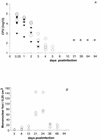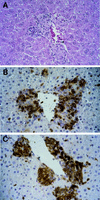Murine model of Bartonella henselae infection in the immunocompetent host
- PMID: 9784568
- PMCID: PMC108694
- DOI: 10.1128/IAI.66.11.5534-5536.1998
Murine model of Bartonella henselae infection in the immunocompetent host
Abstract
Bartonella henselae is an emerging pathogen causing cat scratch disease, bacillary angiomatosis, and peliosis hepatis. Progress in understanding the pathogenesis of and the immune response to these infections has been limited by the lack of an animal model. Following intraperitoneal infection of C57BL/6 mice with B. henselae, organs were cleared of cultivatable bacteria within 6 days. In contrast, B. henselae DNA could be detected in liver tissue for at least 3 months. Liver tissue showed granulomatous inflammation reaching its highest degree of intensity during the fourth week of infection and resolving within 12 weeks postinfection. This mouse model is applicable to the study of the pathogenesis of B. henselae and the immune response to this pathogen in the immunocompetent host.
Figures


Similar articles
-
Bartonella henselae-specific cell-mediated immune responses display a predominantly Th1 phenotype in experimentally infected C57BL/6 mice.Infect Immun. 2001 Oct;69(10):6427-33. doi: 10.1128/IAI.69.10.6427-6433.2001. Infect Immun. 2001. PMID: 11553587 Free PMC article.
-
Immune responses of immunocompetent and immunocompromised mice experimentally infected with Bartonella henselae.J Vet Med Sci. 2003 Apr;65(4):479-84. doi: 10.1292/jvms.65.479. J Vet Med Sci. 2003. PMID: 12736430
-
Peliosis hepatis in cats is not associated with Bartonella henselae infections.Vet Pathol. 2010 Jan;47(1):163-6. doi: 10.1177/0300985809354347. Vet Pathol. 2010. PMID: 20080497
-
Bacillary angiomatosis in immunocompromised patients.AIDS. 1998 Oct 1;12(14):1793-803. doi: 10.1097/00002030-199814000-00011. AIDS. 1998. PMID: 9792380 Review.
-
Bartonella henselae infections in solid organ transplant recipients: report of 5 cases and review of the literature.Medicine (Baltimore). 2012 Mar;91(2):111-121. doi: 10.1097/MD.0b013e31824dc07a. Medicine (Baltimore). 2012. PMID: 22391473 Review.
Cited by
-
Kinetics of Bartonella birtlesii infection in experimentally infected mice and pathogenic effect on reproductive functions.Infect Immun. 2001 Sep;69(9):5313-7. doi: 10.1128/IAI.69.9.5313-5317.2001. Infect Immun. 2001. PMID: 11500400 Free PMC article.
-
Ahnak-knockout mice show susceptibility to Bartonella henselae infection because of CD4+ T cell inactivation and decreased cytokine secretion.BMB Rep. 2019 Apr;52(4):289-294. doi: 10.5483/BMBRep.2019.52.4.310. BMB Rep. 2019. PMID: 30940323 Free PMC article.
-
Evidence of Bacteroides fragilis protection from Bartonella henselae-induced damage.PLoS One. 2012;7(11):e49653. doi: 10.1371/journal.pone.0049653. Epub 2012 Nov 15. PLoS One. 2012. PMID: 23166739 Free PMC article.
-
Bartonella taylorii: A Model Organism for Studying Bartonella Infection in vitro and in vivo.Front Microbiol. 2022 Jul 15;13:913434. doi: 10.3389/fmicb.2022.913434. eCollection 2022. Front Microbiol. 2022. PMID: 35910598 Free PMC article.
-
An immunocompromised murine model of chronic Bartonella infection.Am J Pathol. 2010 Jun;176(6):2753-63. doi: 10.2353/ajpath.2010.090862. Epub 2010 Apr 15. Am J Pathol. 2010. PMID: 20395436 Free PMC article.
References
-
- Cockerell J C, Connor D H. Cat scratch disease. In: Connor D H, Chandler F W, Schwartz D A, Manz H J, Lack E E, editors. Pathology of infectious diseases. Stamford, Conn: Appleton & Lange; 1979. pp. 461–468.
-
- Dolan M J, Wong M T, Regnery R L, Jorgensen J H, Garcia M, Peters J, Drehner D. Syndrome of Rochalimaea henselae adenitis suggesting cat scratch disease. Ann Intern Med. 1993;118:331–336. - PubMed
MeSH terms
Substances
LinkOut - more resources
Full Text Sources
Other Literature Sources
Molecular Biology Databases
Miscellaneous

